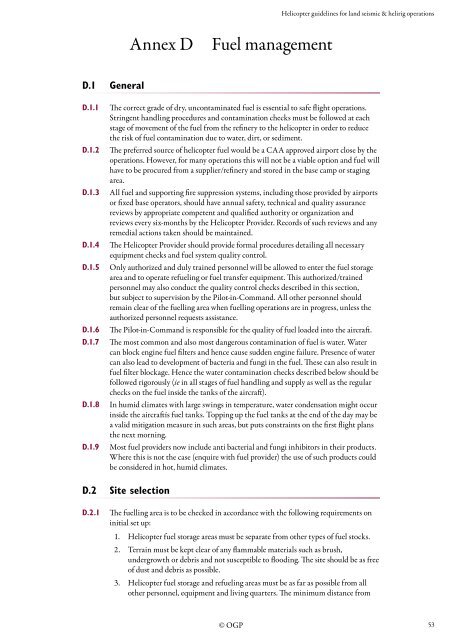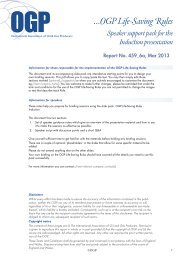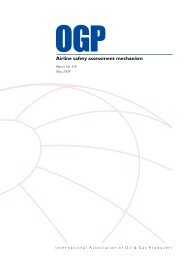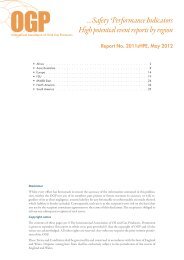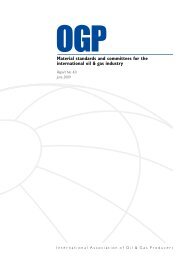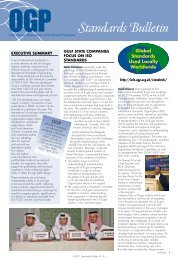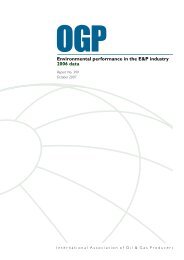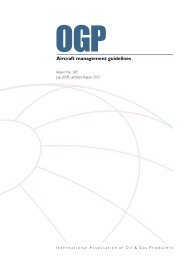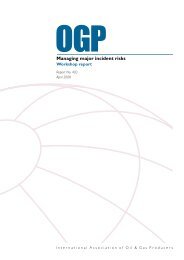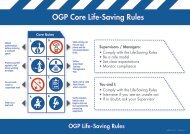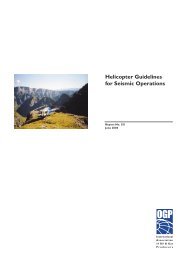Helicopter guidelines for land seismic & helirig operations - OGP
Helicopter guidelines for land seismic & helirig operations - OGP
Helicopter guidelines for land seismic & helirig operations - OGP
Create successful ePaper yourself
Turn your PDF publications into a flip-book with our unique Google optimized e-Paper software.
<strong>Helicopter</strong> <strong>guidelines</strong> <strong>for</strong> <strong>land</strong> <strong>seismic</strong> & <strong>helirig</strong> <strong>operations</strong><br />
Annex D<br />
Fuel management<br />
D.1 General<br />
D.1.1<br />
D.1.2<br />
D.1.3<br />
D.1.4<br />
D.1.5<br />
D.1.6<br />
D.1.7<br />
D.1.8<br />
D.1.9<br />
The correct grade of dry, uncontaminated fuel is essential to safe flight <strong>operations</strong>.<br />
Stringent handling procedures and contamination checks must be followed at each<br />
stage of movement of the fuel from the refinery to the helicopter in order to reduce<br />
the risk of fuel contamination due to water, dirt, or sediment.<br />
The preferred source of helicopter fuel would be a CAA approved airport close by the<br />
<strong>operations</strong>. However, <strong>for</strong> many <strong>operations</strong> this will not be a viable option and fuel will<br />
have to be procured from a supplier/refinery and stored in the base camp or staging<br />
area.<br />
All fuel and supporting fire suppression systems, including those provided by airports<br />
or fixed base operators, should have annual safety, technical and quality assurance<br />
reviews by appropriate competent and qualified authority or organization and<br />
reviews every six-months by the <strong>Helicopter</strong> Provider. Records of such reviews and any<br />
remedial actions taken should be maintained.<br />
The <strong>Helicopter</strong> Provider should provide <strong>for</strong>mal procedures detailing all necessary<br />
equipment checks and fuel system quality control.<br />
Only authorized and duly trained personnel will be allowed to enter the fuel storage<br />
area and to operate refueling or fuel transfer equipment. This authorized/trained<br />
personnel may also conduct the quality control checks described in this section,<br />
but subject to supervision by the Pilot-in-Command. All other personnel should<br />
remain clear of the fuelling area when fuelling <strong>operations</strong> are in progress, unless the<br />
authorized personnel requests assistance.<br />
The Pilot-in-Command is responsible <strong>for</strong> the quality of fuel loaded into the aircraft.<br />
The most common and also most dangerous contamination of fuel is water. Water<br />
can block engine fuel filters and hence cause sudden engine failure. Presence of water<br />
can also lead to development of bacteria and fungi in the fuel. These can also result in<br />
fuel filter blockage. Hence the water contamination checks described below should be<br />
followed rigorously (ie in all stages of fuel handling and supply as well as the regular<br />
checks on the fuel inside the tanks of the aircraft).<br />
In humid climates with large swings in temperature, water condensation might occur<br />
inside the aircraftís fuel tanks. Topping up the fuel tanks at the end of the day may be<br />
a valid mitigation measure in such areas, but puts constraints on the first flight plans<br />
the next morning.<br />
Most fuel providers now include anti bacterial and fungi inhibitors in their products.<br />
Where this is not the case (enquire with fuel provider) the use of such products could<br />
be considered in hot, humid climates.<br />
D.2 Site selection<br />
D.2.1<br />
The fuelling area is to be checked in accordance with the following requirements on<br />
initial set up:<br />
1. <strong>Helicopter</strong> fuel storage areas must be separate from other types of fuel stocks.<br />
2. Terrain must be kept clear of any flammable materials such as brush,<br />
undergrowth or debris and not susceptible to flooding. The site should be as free<br />
of dust and debris as possible.<br />
3. <strong>Helicopter</strong> fuel storage and refueling areas must be as far as possible from all<br />
other personnel, equipment and living quarters. The minimum distance from<br />
© <strong>OGP</strong><br />
53


